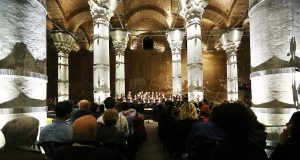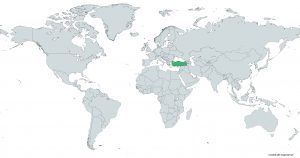Cantar con estilo: el panorama coral turco
Burak Onur Erdem, coral director, Turquía
Turquía es un país donde un estilo coral único ha florecido desde principios del siglo XX. Dado que la herencia del suelo de Anatolia abarca una variedad de antecedentes musicales regados por el este y el oeste, también ha afectado la cultura del canto colectivo del país. A lo largo del siglo, a medida que los coros y las sociedades corales comenzaron a florecer, una particular producción compositiva ha seguido también esta tendencia. Si miramos al pasado desde el siglo XXI, es evidente que el matrimonio entre la polifonía occidental y la cultura microtonal oriental se está haciendo realidad en esta tierra de puentes culturales.
La tradición coral de Turquía se remonta a los primeros años de la República. Aunque hubo algunas iniciativas corales individuales a finales del período del Imperio Otomano, fundadas principalmente por minorías, sería apropiado afirmar que las primeras actividades corales organizadas comenzaron alrededor de la década de 1920. La Escuela de Profesores de Música fundada en 1924 constituye un hito en la política musical de la nueva República. Varias sociedades corales comenzaron a florecer a principios de la década de 1930 en grandes ciudades como Estambul, Ankara e İzmir. En las últimas décadas, los conservatorios y las escuelas de música han sido importante un centro para la producción e interpretación de música coral. La vida coral turca no solo se limita a música escolar, sino también ha estado allí la producción sinfónico-coral y a cappella desde el comienzo de la República. El fin de la década de 1970 y la de 1980 coinciden con la fundación de los primeros coros profesionales a cappella y sinfónicos con apoyo público y los años ‘90 y 2000 pueden caracterizarse por el florecimiento de los coros amateurs organizados en diferentes ciudades clave de Turquía. Desde 2010, Turquía ha sido bendecida con numerosos festivales corales, varias organizaciones corales, coros de renombre internacional y un aumento drástico en las actividades educativas en Dirección coral.
Antes de adentrarse en el mundo coral de Turquía, uno debe equiparse con la terminología que utiliza el país para distinguir la música coral polifónica de la llamada música coral monofónica. La escena coral en Turquía contiene una serie de coros con el nombre “polifónico” y también un gran número que se define a sí mismo por igual, señalando la herencia musical occidental. En contraste, la música folklórica o los coros de música clásica turca se describen como monofónicos, donde los cantantes cantan una línea microtonal con ornamentación tradicional. Sin embargo, el autor no cree en las distinciones puramente técnicas de la sociedad coral, ya que el propio canto colectivo es el principal denominador común de cada coro que participa en este recorrido musical. La función de las sociedades corales, la calidad de las técnicas compositiva e interpretativa, y la expresión del contenido musical a través de la práctica común son formas mucho más interesantes de abordar el panorama coral de un país.

La composición coral en Turquía comenzó con el material de la música folklórica. Escrita principalmente en las décadas de 1930 y 1940, la primera escuela de composición de música clásica turca se llama “Los cinco turcos”. Los siguientes nombres, nacidos a principios del siglo XX, constituyen los fundamentos de la producción musical de la nueva República: Ahmed Adnan Saygun, Ulvi Cemal Erkin, Cemal Reşit Rey, Hasan Ferid Alnar y Necil Kazım Akses. Aunque el material ha sido principalmente melodías populares, el primer oratorio turco fue compuesto por Saygun en 1943. “Yunus Emre Oratorio” cuenta la historia del místico del siglo XIII Yunus Emre, escrito en forma de oratorio clásico adornado con un sabor a música religiosa turca. La segunda generación de compositores incluye nombres como Muammer Sun, Cenan Akın, Nevit Kodallı, Yalçın Tura y otros. La principal influencia de los compositores nacidos en las décadas de 1920 y 1930 son temas de epopeyas nacionales y material folklórico. Los compositores de vanguardia con producción coral de principios del siglo XX también incluyen a İlhan Usmanbaş y Ertuğrul Oğuz Fırat.
Los compositores nacidos en los años ‘50 y ‘60 tienen una producción coral considerable: Turgay Erdener, Kamran İnce, Hasan Uçarsu, Özkan Manav, Mehmet Nemutlu. Uçarsu, muy probablemente, no solo es el compositor con el mayor número de obras corales a cappella, sino que también representa una madurez estilística de la escritura coral. Sus obras dan cabida a una fusión muy fina de música clásica turca, música folclórica y material polifónico original. Puede que no sea sorprendente que Uçarsu sea uno de los compositores más populares entre los coros del país.
Fazıl Say, pianista turco de renombre internacional, ha hecho una contribución notable al repertorio coral con el oratorio Nazım, que contiene una fuerte narración sobre el poeta turco del siglo XX Nazım Hikmet. Luego viene la nueva generación, nacida a finales de los años ‘70 y ‘80. Estos contemporáneos incluyen nombres como Mesruh Savaş, Volkan Akkoç, Recep Gül. Los jóvenes compositores del país son especialmente sólidos al combinar los nuevos timbres de la música coral del siglo XXI con la extraña fórmula de la escritura coral turca que existe desde hace casi un siglo.
No sería inexacto sugerir que la escritura coral turca tiene algunas cualidades de marca exclusiva del país. Una característica común es la estructura rítmica irregular en la que indicaciones de compás como 5/8, 7/8 o 9/8 se consideran habituales. Esto también se puede observar en la producción coral del sudeste de Europa y los Balcanes. Otra cualidad que es importante para Anatolia es el fondo microtonal en la estructura melódica. El makam, que corresponde a la estructura de escala de la música clásica turca, es una de las principales influencias en los compositores contemporáneos. Eventualmente, la influencia de la música makam también tiene sus propias implicaciones armónicas, donde un intervalo de 2ª mayor o 2ª menor tiene una connotación totalmente diferente en la música coral turca que en la música tradicional europea. Además de eso, la estructura modal de la música folklórica genera un enfoque armónico basado en la 4ª como una unidad, en lugar de la 3ª. Esto permite que un acorde con 4ª suspendida funcione como resolución en lugar de como suspensión como en la armonía occidental.
Más características de este estilo compositivo específico pueden eventualmente ser elaboradas en detalle en otro artículo. Sin embargo, el lector puede obtener una impresión general del panorama coral turco a través de este artículo, que para nada tiene la intención de ser una guía completa el panorama de la composición coral en Turquía. Se puede encontrar en línea más información sobre cada compositor y compositores más establecidos, a través de las actuaciones de coros turcos y publicaciones de escuelas de música y conservatorios.
 El Dr. BURAK ONUR ERDEM (*1986) estudió Teoría musical y Dirección en Estambul junto con una licenciatura en Ciencias políticas y Relaciones internacionales. Ha perfeccionado sus habilidades en Dirección coral en clases magistrales con Johannes Prinz, Maria Guinand, Volker Hempfling, Anders Eby, Denes Szabo y Michael Gohl. Terminó sus estudios de posgrado en Dirección coral con el Prof. Johannes Prinz en la Kunstuniversität Graz, Austria. Erdem es miembro de la Junta directiva de la Asociación Coral Europea y la Federación Internacional de Música Coral. Actualmente es el presidente de la Comisión de Música de Leading Voices 2022. Ha sido galardonado con el “Premio al Mejor Director Joven” en el 38º Concurso Coral Internacional de Varna y ha sido miembro del jurado en el 66º Concurso Coral Internacional de Arezzo. Erdem es el director principal del Coro Estatal Turco y del Coro de Cámara Rezonans con sede en Estambul.
El Dr. BURAK ONUR ERDEM (*1986) estudió Teoría musical y Dirección en Estambul junto con una licenciatura en Ciencias políticas y Relaciones internacionales. Ha perfeccionado sus habilidades en Dirección coral en clases magistrales con Johannes Prinz, Maria Guinand, Volker Hempfling, Anders Eby, Denes Szabo y Michael Gohl. Terminó sus estudios de posgrado en Dirección coral con el Prof. Johannes Prinz en la Kunstuniversität Graz, Austria. Erdem es miembro de la Junta directiva de la Asociación Coral Europea y la Federación Internacional de Música Coral. Actualmente es el presidente de la Comisión de Música de Leading Voices 2022. Ha sido galardonado con el “Premio al Mejor Director Joven” en el 38º Concurso Coral Internacional de Varna y ha sido miembro del jurado en el 66º Concurso Coral Internacional de Arezzo. Erdem es el director principal del Coro Estatal Turco y del Coro de Cámara Rezonans con sede en Estambul.
Traducido del inglés por Oscar Llobet, Argentina
